Analysis of Accounts Receivable: Auditing Theory and Practice Report
VerifiedAdded on 2021/06/17
|14
|1846
|131
Report
AI Summary
This report provides a comprehensive analysis of accounts receivable auditing, beginning with an introduction to accounts receivable and the associated risks, including credit facility issues, inadequate credit checks, inefficient procedures, and non-collectable debts. The report then presents a detailed audit, including an analysis of trade and other receivables, identification of duplicate invoices and negative balances, and an aging analysis of debtors. It further calculates the provision for bad debts and examines instances of overstatement in accounts receivable. The report highlights the importance of accurate financial reporting and concludes with the significance of thorough auditing procedures to ensure the reliability of financial statements. The analysis includes specific examples of invoice discrepancies and their impact on financial reporting, ultimately emphasizing the need for robust internal controls and diligent auditing practices.
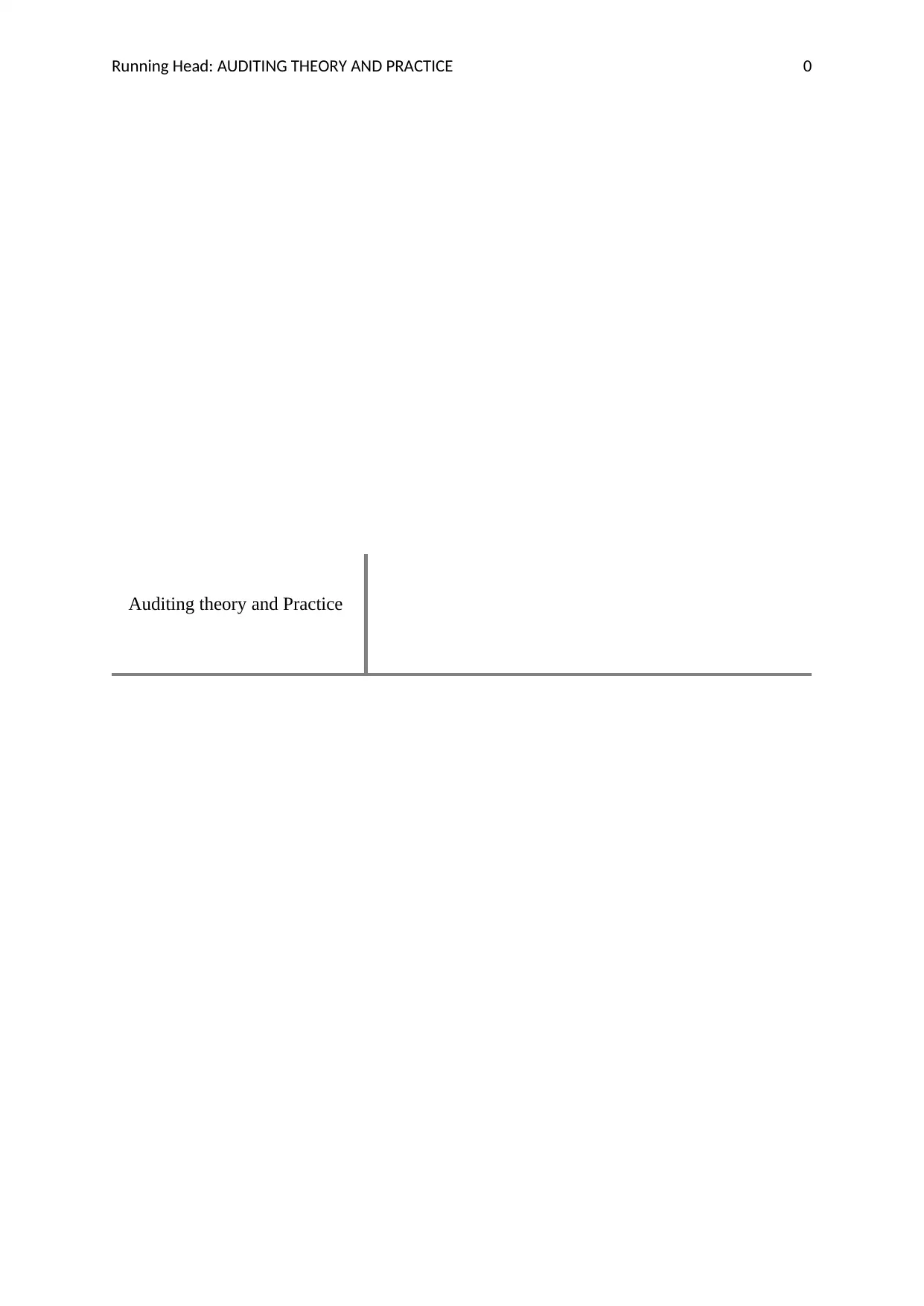
Running Head: AUDITING THEORY AND PRACTICE 0
Auditing theory and Practice
Auditing theory and Practice
Paraphrase This Document
Need a fresh take? Get an instant paraphrase of this document with our AI Paraphraser
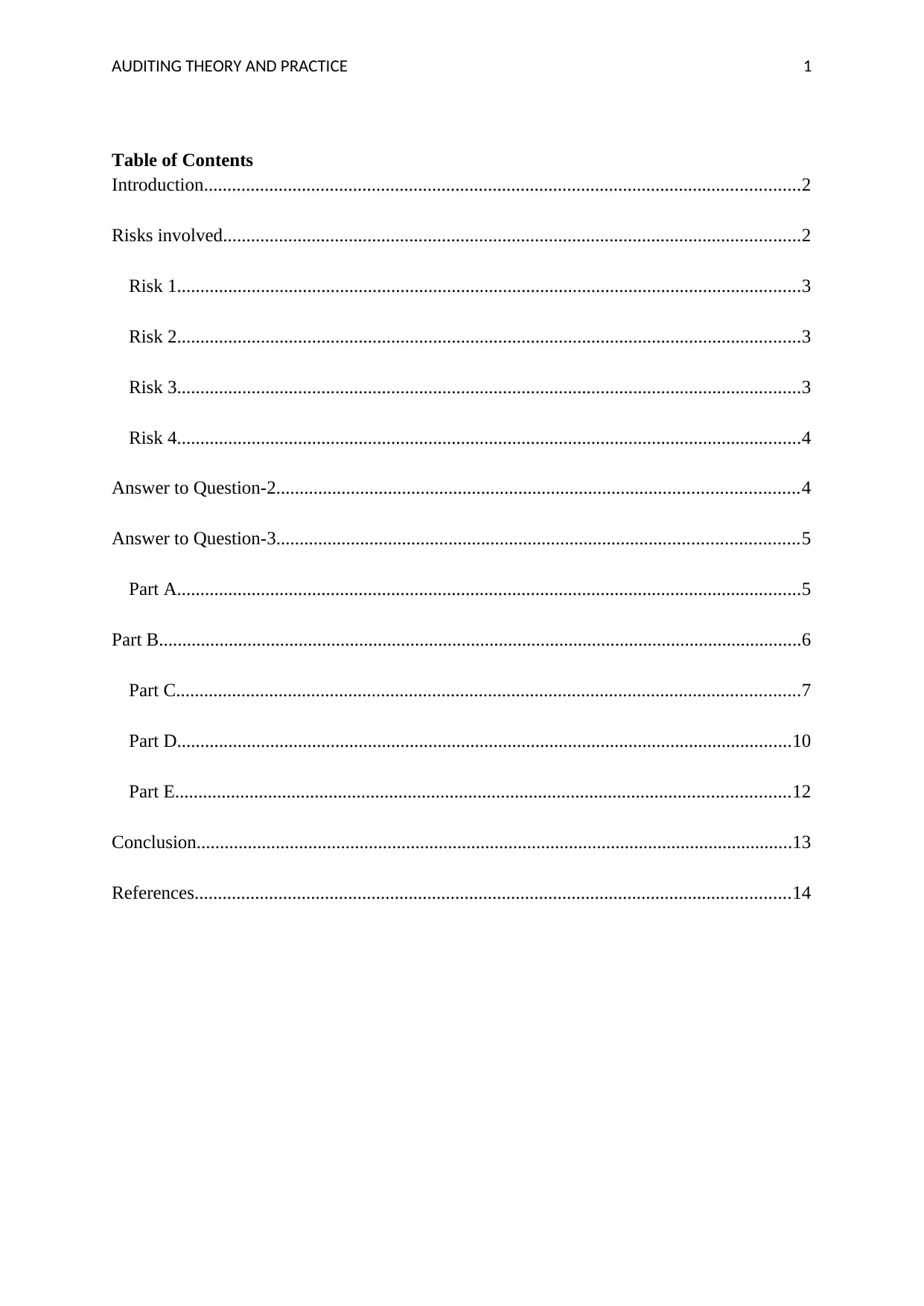
AUDITING THEORY AND PRACTICE 1
Table of Contents
Introduction................................................................................................................................2
Risks involved............................................................................................................................2
Risk 1......................................................................................................................................3
Risk 2......................................................................................................................................3
Risk 3......................................................................................................................................3
Risk 4......................................................................................................................................4
Answer to Question-2................................................................................................................4
Answer to Question-3................................................................................................................5
Part A......................................................................................................................................5
Part B..........................................................................................................................................6
Part C......................................................................................................................................7
Part D....................................................................................................................................10
Part E....................................................................................................................................12
Conclusion................................................................................................................................13
References................................................................................................................................14
Table of Contents
Introduction................................................................................................................................2
Risks involved............................................................................................................................2
Risk 1......................................................................................................................................3
Risk 2......................................................................................................................................3
Risk 3......................................................................................................................................3
Risk 4......................................................................................................................................4
Answer to Question-2................................................................................................................4
Answer to Question-3................................................................................................................5
Part A......................................................................................................................................5
Part B..........................................................................................................................................6
Part C......................................................................................................................................7
Part D....................................................................................................................................10
Part E....................................................................................................................................12
Conclusion................................................................................................................................13
References................................................................................................................................14
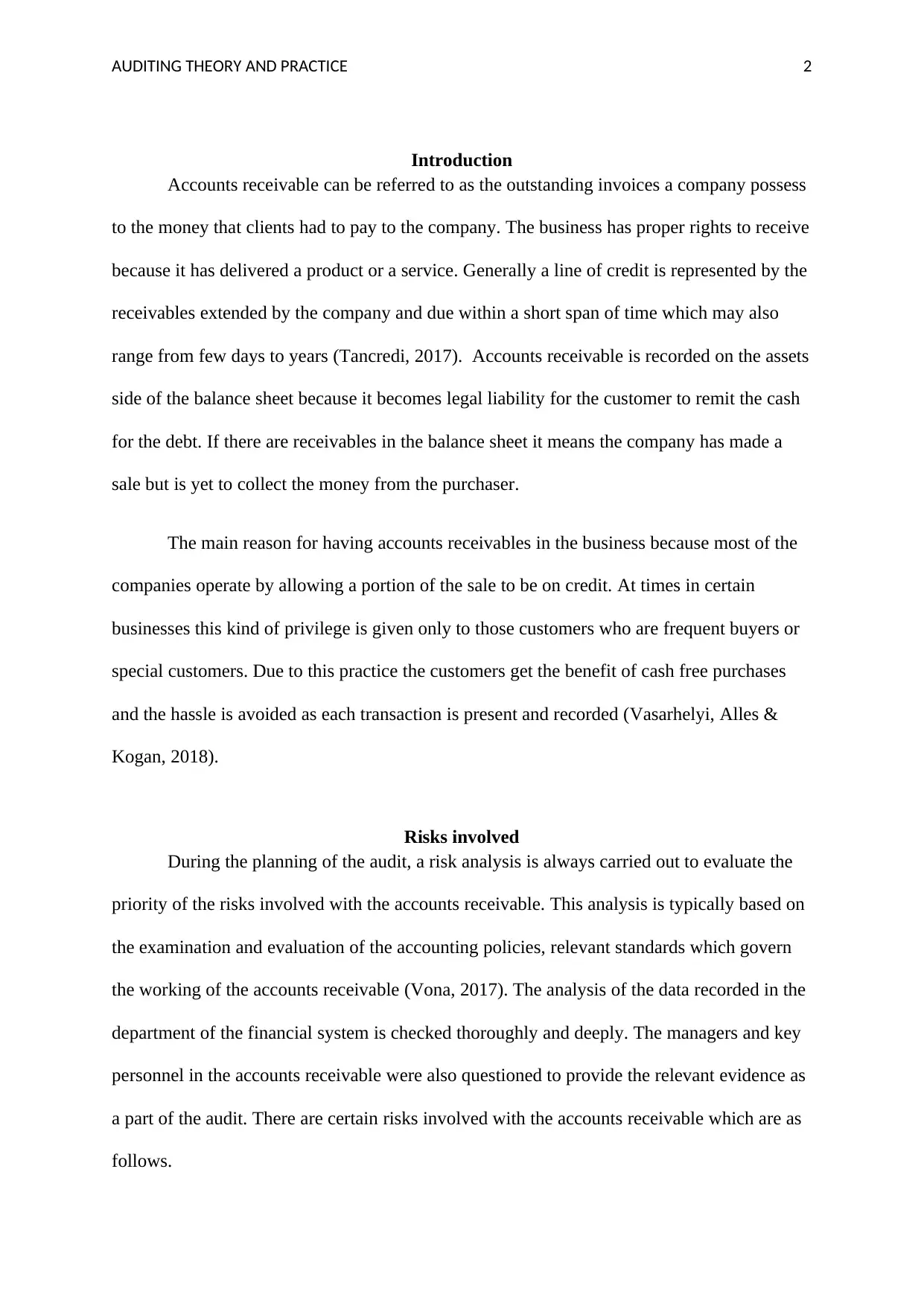
AUDITING THEORY AND PRACTICE 2
Introduction
Accounts receivable can be referred to as the outstanding invoices a company possess
to the money that clients had to pay to the company. The business has proper rights to receive
because it has delivered a product or a service. Generally a line of credit is represented by the
receivables extended by the company and due within a short span of time which may also
range from few days to years (Tancredi, 2017). Accounts receivable is recorded on the assets
side of the balance sheet because it becomes legal liability for the customer to remit the cash
for the debt. If there are receivables in the balance sheet it means the company has made a
sale but is yet to collect the money from the purchaser.
The main reason for having accounts receivables in the business because most of the
companies operate by allowing a portion of the sale to be on credit. At times in certain
businesses this kind of privilege is given only to those customers who are frequent buyers or
special customers. Due to this practice the customers get the benefit of cash free purchases
and the hassle is avoided as each transaction is present and recorded (Vasarhelyi, Alles &
Kogan, 2018).
Risks involved
During the planning of the audit, a risk analysis is always carried out to evaluate the
priority of the risks involved with the accounts receivable. This analysis is typically based on
the examination and evaluation of the accounting policies, relevant standards which govern
the working of the accounts receivable (Vona, 2017). The analysis of the data recorded in the
department of the financial system is checked thoroughly and deeply. The managers and key
personnel in the accounts receivable were also questioned to provide the relevant evidence as
a part of the audit. There are certain risks involved with the accounts receivable which are as
follows.
Introduction
Accounts receivable can be referred to as the outstanding invoices a company possess
to the money that clients had to pay to the company. The business has proper rights to receive
because it has delivered a product or a service. Generally a line of credit is represented by the
receivables extended by the company and due within a short span of time which may also
range from few days to years (Tancredi, 2017). Accounts receivable is recorded on the assets
side of the balance sheet because it becomes legal liability for the customer to remit the cash
for the debt. If there are receivables in the balance sheet it means the company has made a
sale but is yet to collect the money from the purchaser.
The main reason for having accounts receivables in the business because most of the
companies operate by allowing a portion of the sale to be on credit. At times in certain
businesses this kind of privilege is given only to those customers who are frequent buyers or
special customers. Due to this practice the customers get the benefit of cash free purchases
and the hassle is avoided as each transaction is present and recorded (Vasarhelyi, Alles &
Kogan, 2018).
Risks involved
During the planning of the audit, a risk analysis is always carried out to evaluate the
priority of the risks involved with the accounts receivable. This analysis is typically based on
the examination and evaluation of the accounting policies, relevant standards which govern
the working of the accounts receivable (Vona, 2017). The analysis of the data recorded in the
department of the financial system is checked thoroughly and deeply. The managers and key
personnel in the accounts receivable were also questioned to provide the relevant evidence as
a part of the audit. There are certain risks involved with the accounts receivable which are as
follows.
⊘ This is a preview!⊘
Do you want full access?
Subscribe today to unlock all pages.

Trusted by 1+ million students worldwide

AUDITING THEORY AND PRACTICE 3
Paraphrase This Document
Need a fresh take? Get an instant paraphrase of this document with our AI Paraphraser

AUDITING THEORY AND PRACTICE 4
Risk 1
The customers are allowed a superior level of credit facility. This facility at times
becomes beyond the capacity or willingness to pay. This will ultimately damage our business
performance (Mian & Smith, 2016). Due to this the debtors repay their debts slow. The
amounts are over disputed, the ability of the company to recover all the debts fails, it can also
cause financial loss to the organisation and the profits are also reduced to a greater extent.
The balances do no match and the cash flows remain incomplete.
Risk 2
At times the credit checks are not undertaken prior to allowing credit, which
ultimately leads to more number of days of repayment. There is a risk of reviewing the credit
limits of each individual deeply. If the organisation is dealing with the potential debtors from
a long period they feel that the chances of occurrence of bad debts is low, and they allow the
facility without checking the credit limit and forget to set indicators (Kai, et al 2017).
Risk 3
Inefficient and ineffective procedures of proving accounts receivables will hinder the
ability of the organisation to collect debts on time and in right fashion. This generally
happens when the supporting documents are not sufficient and proper to record for the
transactions and balances. The transactions are not processed correctly. The loss of working
papers also leads to difficulty in proving the debt which ultimately results in the write off
(Chartered Institute of Internal Auditors, 2018).
Risk of not recording the transactions as and when they incur, resulting in poor
working capital management through the slow recovery of cash receipts. Inaccurate balances
also leads to disputes and clashes by debtors, delays in payments and/or unnecessary recovery
action taken.
Risk 1
The customers are allowed a superior level of credit facility. This facility at times
becomes beyond the capacity or willingness to pay. This will ultimately damage our business
performance (Mian & Smith, 2016). Due to this the debtors repay their debts slow. The
amounts are over disputed, the ability of the company to recover all the debts fails, it can also
cause financial loss to the organisation and the profits are also reduced to a greater extent.
The balances do no match and the cash flows remain incomplete.
Risk 2
At times the credit checks are not undertaken prior to allowing credit, which
ultimately leads to more number of days of repayment. There is a risk of reviewing the credit
limits of each individual deeply. If the organisation is dealing with the potential debtors from
a long period they feel that the chances of occurrence of bad debts is low, and they allow the
facility without checking the credit limit and forget to set indicators (Kai, et al 2017).
Risk 3
Inefficient and ineffective procedures of proving accounts receivables will hinder the
ability of the organisation to collect debts on time and in right fashion. This generally
happens when the supporting documents are not sufficient and proper to record for the
transactions and balances. The transactions are not processed correctly. The loss of working
papers also leads to difficulty in proving the debt which ultimately results in the write off
(Chartered Institute of Internal Auditors, 2018).
Risk of not recording the transactions as and when they incur, resulting in poor
working capital management through the slow recovery of cash receipts. Inaccurate balances
also leads to disputes and clashes by debtors, delays in payments and/or unnecessary recovery
action taken.
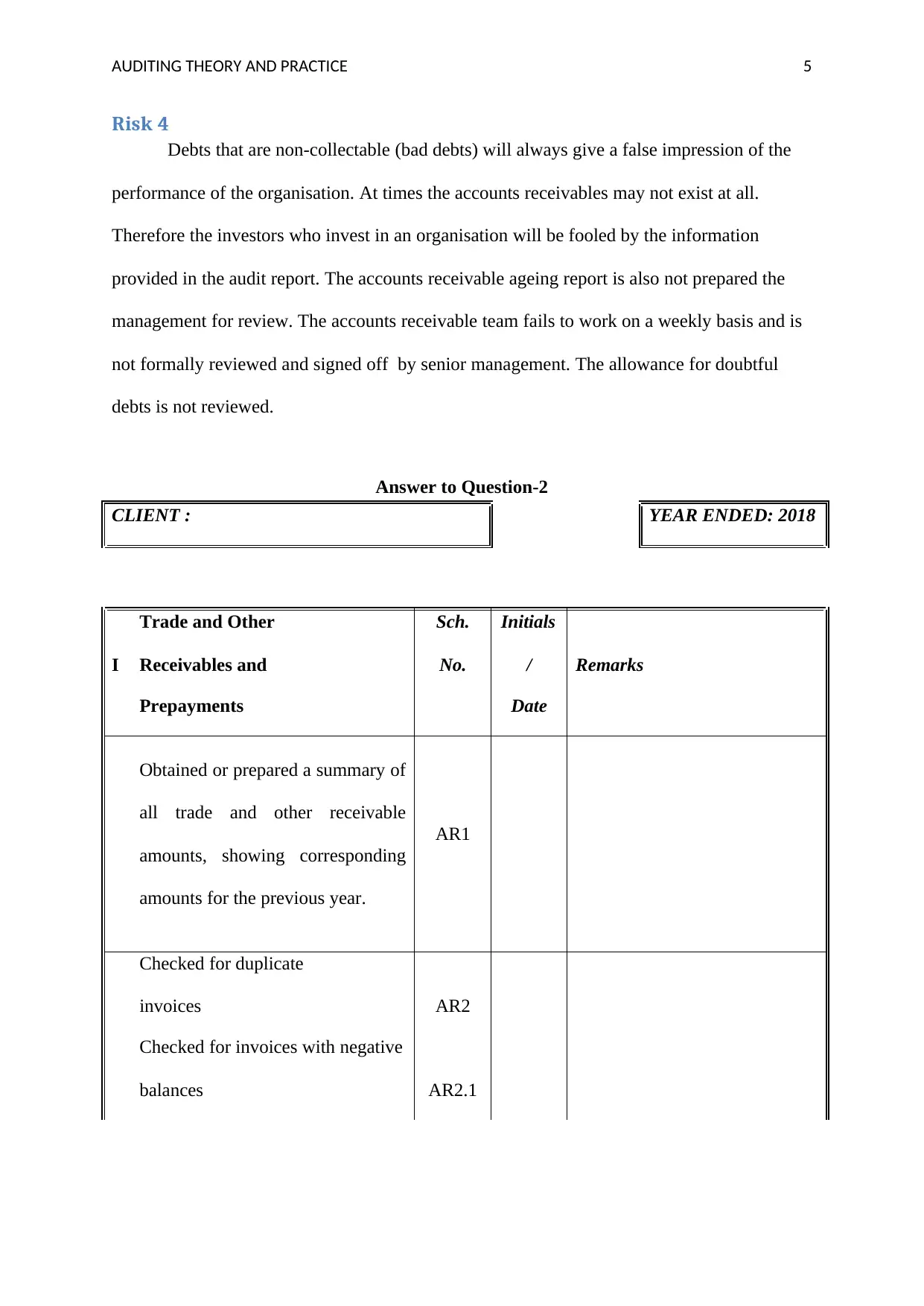
AUDITING THEORY AND PRACTICE 5
Risk 4
Debts that are non-collectable (bad debts) will always give a false impression of the
performance of the organisation. At times the accounts receivables may not exist at all.
Therefore the investors who invest in an organisation will be fooled by the information
provided in the audit report. The accounts receivable ageing report is also not prepared the
management for review. The accounts receivable team fails to work on a weekly basis and is
not formally reviewed and signed off by senior management. The allowance for doubtful
debts is not reviewed.
Answer to Question-2
CLIENT : YEAR ENDED: 2018
I
Trade and Other
Receivables and
Sch.
No.
Initials
/ Remarks
Prepayments Date
Obtained or prepared a summary of
all trade and other receivable
amounts, showing corresponding
amounts for the previous year.
AR1
Checked for duplicate
invoices AR2
Checked for invoices with negative
balances AR2.1
Risk 4
Debts that are non-collectable (bad debts) will always give a false impression of the
performance of the organisation. At times the accounts receivables may not exist at all.
Therefore the investors who invest in an organisation will be fooled by the information
provided in the audit report. The accounts receivable ageing report is also not prepared the
management for review. The accounts receivable team fails to work on a weekly basis and is
not formally reviewed and signed off by senior management. The allowance for doubtful
debts is not reviewed.
Answer to Question-2
CLIENT : YEAR ENDED: 2018
I
Trade and Other
Receivables and
Sch.
No.
Initials
/ Remarks
Prepayments Date
Obtained or prepared a summary of
all trade and other receivable
amounts, showing corresponding
amounts for the previous year.
AR1
Checked for duplicate
invoices AR2
Checked for invoices with negative
balances AR2.1
⊘ This is a preview!⊘
Do you want full access?
Subscribe today to unlock all pages.

Trusted by 1+ million students worldwide

AUDITING THEORY AND PRACTICE 6
Identified credit notes
with positive values AR2.2
Prepared a revised schedule for
accounts receivable
AR3
Prepared age analysis of
receivables AR4
-identify balances beyond
45 days AR4.1
-Review and ensure
provision for bad debts.
AR4.2
Answer to Question-3
Part A.
Ageing Analysis of Debtors
AA Stratum 0-1day up to 45
days
up to
120
days
more
than
120
days
Balance
AR4 AR 4.1
47 3 1
44 2 1
41 2 1
40 2 1
39 2 1
37 2 1
Identified credit notes
with positive values AR2.2
Prepared a revised schedule for
accounts receivable
AR3
Prepared age analysis of
receivables AR4
-identify balances beyond
45 days AR4.1
-Review and ensure
provision for bad debts.
AR4.2
Answer to Question-3
Part A.
Ageing Analysis of Debtors
AA Stratum 0-1day up to 45
days
up to
120
days
more
than
120
days
Balance
AR4 AR 4.1
47 3 1
44 2 1
41 2 1
40 2 1
39 2 1
37 2 1
Paraphrase This Document
Need a fresh take? Get an instant paraphrase of this document with our AI Paraphraser
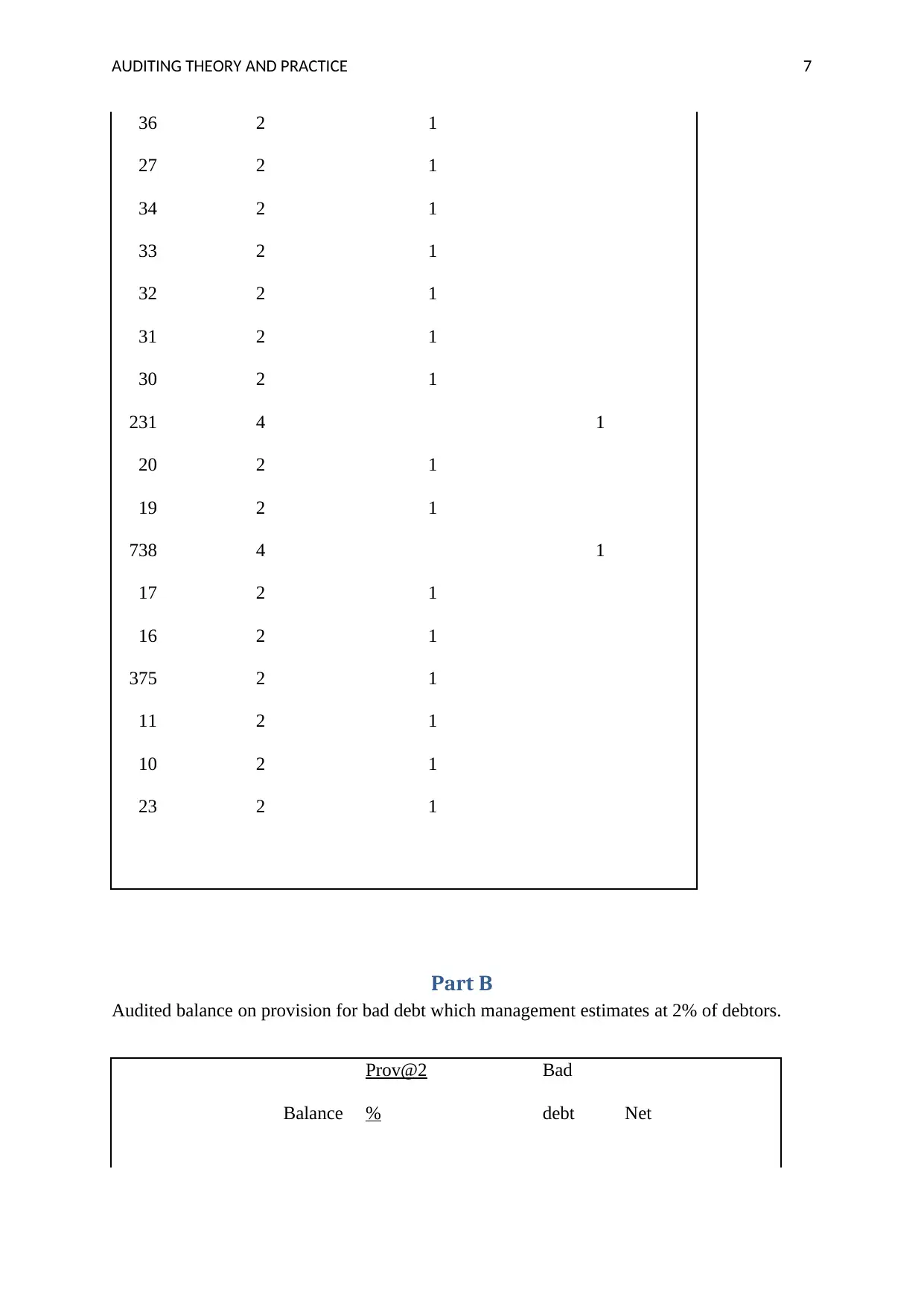
AUDITING THEORY AND PRACTICE 7
36 2 1
27 2 1
34 2 1
33 2 1
32 2 1
31 2 1
30 2 1
231 4 1
20 2 1
19 2 1
738 4 1
17 2 1
16 2 1
375 2 1
11 2 1
10 2 1
23 2 1
Part B
Audited balance on provision for bad debt which management estimates at 2% of debtors.
Balance
Prov@2
%
Bad
debt Net
36 2 1
27 2 1
34 2 1
33 2 1
32 2 1
31 2 1
30 2 1
231 4 1
20 2 1
19 2 1
738 4 1
17 2 1
16 2 1
375 2 1
11 2 1
10 2 1
23 2 1
Part B
Audited balance on provision for bad debt which management estimates at 2% of debtors.
Balance
Prov@2
%
Bad
debt Net

AUDITING THEORY AND PRACTICE 8
As per sheet 1 5748.62 114.9724
5633.64
8
Revised Balance 7765.92 155.3184
7610.60
2 3700.84 3909.76
Overstatement (5633.64-3909.76) 1723.89
Accounts Receivables contain a number of duplicate invoice
There are sale(s) invoice with negative balance(s)
Accounts Receivable was overstated but with adjustments
The correct balance is 3909.76
Part C
AR 2 Duplicated invoices, invoices with negative balances and credit notes
with positive balances
Doc.
No.
Doc.
Type
TRN Date AMT Due Date PMT
Date
AMTPAI
D
BAL
56016 IN 02-02-
2016
736.74 02-03-
2016
02-06-
2016
520 216.7
4
56016 IN 04-02-
2016
-1070.92 03-03-
2016
04-06-
2016
0 -
1070.
92
65003 IN 08-02-
2016
1189.11 07-03-
2016
15-03-
2016
1190 -0.89
65003 IN 11-02- 1189.11 10-03- 25-04- 1189.11 0
As per sheet 1 5748.62 114.9724
5633.64
8
Revised Balance 7765.92 155.3184
7610.60
2 3700.84 3909.76
Overstatement (5633.64-3909.76) 1723.89
Accounts Receivables contain a number of duplicate invoice
There are sale(s) invoice with negative balance(s)
Accounts Receivable was overstated but with adjustments
The correct balance is 3909.76
Part C
AR 2 Duplicated invoices, invoices with negative balances and credit notes
with positive balances
Doc.
No.
Doc.
Type
TRN Date AMT Due Date PMT
Date
AMTPAI
D
BAL
56016 IN 02-02-
2016
736.74 02-03-
2016
02-06-
2016
520 216.7
4
56016 IN 04-02-
2016
-1070.92 03-03-
2016
04-06-
2016
0 -
1070.
92
65003 IN 08-02-
2016
1189.11 07-03-
2016
15-03-
2016
1190 -0.89
65003 IN 11-02- 1189.11 10-03- 25-04- 1189.11 0
⊘ This is a preview!⊘
Do you want full access?
Subscribe today to unlock all pages.

Trusted by 1+ million students worldwide

AUDITING THEORY AND PRACTICE 9
2016 2016 2016
65003 IN 17-02-
2016
1189.11 16-03-
2016
30-04-
2016
1189.11 0
65003 IN 06-03-
2016
1189.11 03-01-
2016
28-06-
2016
600 589.1
1
65004 IN 18-02-
2016
1280.2 17-03-
2016
30-04-
2016
1576 -295.8
65004 IN 04-03-
2016
1280.2 01-04-
2016
26-06-
2016
1189.11 91.09
65009 IN 03-03-
2016
1465.42 31-03-
2016
25-06-
2016
1321.24 144.1
8
65010 IN 20-02-
2016
1771.46 19-03-
2016
25-04-
2016
615.64 1155.
82
65011 IN 21-02-
2016
3152.46 20-03-
2016
26-04-
2016
2801.2 351.2
6
65012 IN 22-02-
2016
615.64 21-03-
2016
27-04-
2016
4954.64 -4339
65013 IN 24-02-
2016
1755.52 23-03-
2016
29-04-
2016
2069.13 -
313.6
1
65016 IN 09-03-
2016
2397.31 06-04-
2016
21-05-
2016
1494.13 903.1
8
65017 IN 05-03-
2016
1981.62 02-04-
2016
27-06-
2016
619.94 1361.
68
Total 20122.0 -
2016 2016 2016
65003 IN 17-02-
2016
1189.11 16-03-
2016
30-04-
2016
1189.11 0
65003 IN 06-03-
2016
1189.11 03-01-
2016
28-06-
2016
600 589.1
1
65004 IN 18-02-
2016
1280.2 17-03-
2016
30-04-
2016
1576 -295.8
65004 IN 04-03-
2016
1280.2 01-04-
2016
26-06-
2016
1189.11 91.09
65009 IN 03-03-
2016
1465.42 31-03-
2016
25-06-
2016
1321.24 144.1
8
65010 IN 20-02-
2016
1771.46 19-03-
2016
25-04-
2016
615.64 1155.
82
65011 IN 21-02-
2016
3152.46 20-03-
2016
26-04-
2016
2801.2 351.2
6
65012 IN 22-02-
2016
615.64 21-03-
2016
27-04-
2016
4954.64 -4339
65013 IN 24-02-
2016
1755.52 23-03-
2016
29-04-
2016
2069.13 -
313.6
1
65016 IN 09-03-
2016
2397.31 06-04-
2016
21-05-
2016
1494.13 903.1
8
65017 IN 05-03-
2016
1981.62 02-04-
2016
27-06-
2016
619.94 1361.
68
Total 20122.0 -
Paraphrase This Document
Need a fresh take? Get an instant paraphrase of this document with our AI Paraphraser

AUDITING THEORY AND PRACTICE 10
9 1207.
16
Only first invoice is considered as genuine
transaction.
Only the first invoice is considered genuine for all the invoices
bearing the same number.
Sales over stated by 19921.81 and accounts receivable understated by
4709.36.
AR 2.1 Invoices with negative value and
balances
Invoice Amount
IN5601
6 1070.92
IN6500
3 0.89
IN6500
4 295.80
IN6500
3 0.89
IN6501
2 4339.00
IN6501
3 313.61
9 1207.
16
Only first invoice is considered as genuine
transaction.
Only the first invoice is considered genuine for all the invoices
bearing the same number.
Sales over stated by 19921.81 and accounts receivable understated by
4709.36.
AR 2.1 Invoices with negative value and
balances
Invoice Amount
IN5601
6 1070.92
IN6500
3 0.89
IN6500
4 295.80
IN6500
3 0.89
IN6501
2 4339.00
IN6501
3 313.61
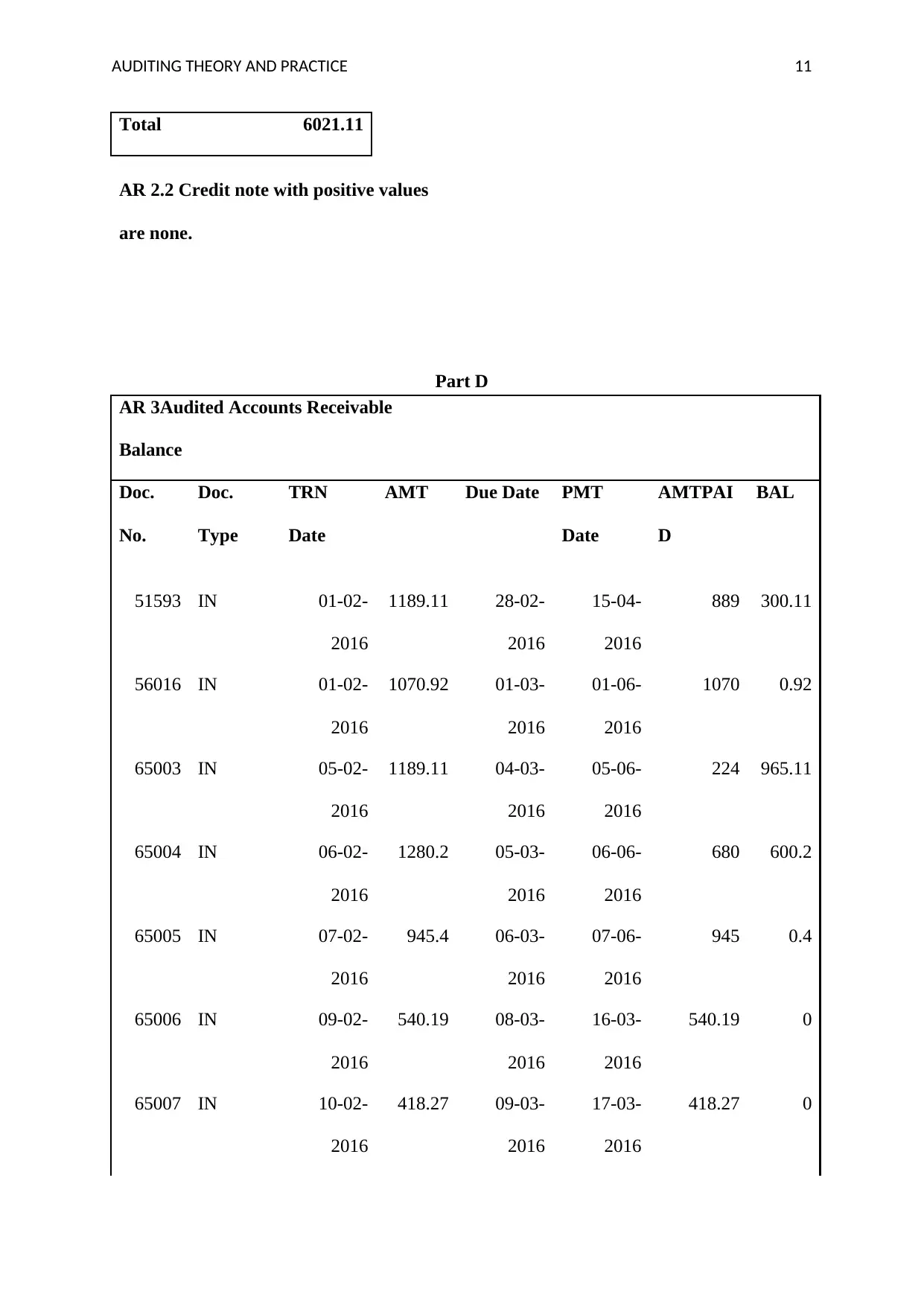
AUDITING THEORY AND PRACTICE 11
Total 6021.11
AR 2.2 Credit note with positive values
are none.
Part D
AR 3Audited Accounts Receivable
Balance
Doc.
No.
Doc.
Type
TRN
Date
AMT Due Date PMT
Date
AMTPAI
D
BAL
51593 IN 01-02-
2016
1189.11 28-02-
2016
15-04-
2016
889 300.11
56016 IN 01-02-
2016
1070.92 01-03-
2016
01-06-
2016
1070 0.92
65003 IN 05-02-
2016
1189.11 04-03-
2016
05-06-
2016
224 965.11
65004 IN 06-02-
2016
1280.2 05-03-
2016
06-06-
2016
680 600.2
65005 IN 07-02-
2016
945.4 06-03-
2016
07-06-
2016
945 0.4
65006 IN 09-02-
2016
540.19 08-03-
2016
16-03-
2016
540.19 0
65007 IN 10-02-
2016
418.27 09-03-
2016
17-03-
2016
418.27 0
Total 6021.11
AR 2.2 Credit note with positive values
are none.
Part D
AR 3Audited Accounts Receivable
Balance
Doc.
No.
Doc.
Type
TRN
Date
AMT Due Date PMT
Date
AMTPAI
D
BAL
51593 IN 01-02-
2016
1189.11 28-02-
2016
15-04-
2016
889 300.11
56016 IN 01-02-
2016
1070.92 01-03-
2016
01-06-
2016
1070 0.92
65003 IN 05-02-
2016
1189.11 04-03-
2016
05-06-
2016
224 965.11
65004 IN 06-02-
2016
1280.2 05-03-
2016
06-06-
2016
680 600.2
65005 IN 07-02-
2016
945.4 06-03-
2016
07-06-
2016
945 0.4
65006 IN 09-02-
2016
540.19 08-03-
2016
16-03-
2016
540.19 0
65007 IN 10-02-
2016
418.27 09-03-
2016
17-03-
2016
418.27 0
⊘ This is a preview!⊘
Do you want full access?
Subscribe today to unlock all pages.

Trusted by 1+ million students worldwide
1 out of 14
Related Documents
Your All-in-One AI-Powered Toolkit for Academic Success.
+13062052269
info@desklib.com
Available 24*7 on WhatsApp / Email
![[object Object]](/_next/static/media/star-bottom.7253800d.svg)
Unlock your academic potential
Copyright © 2020–2025 A2Z Services. All Rights Reserved. Developed and managed by ZUCOL.




